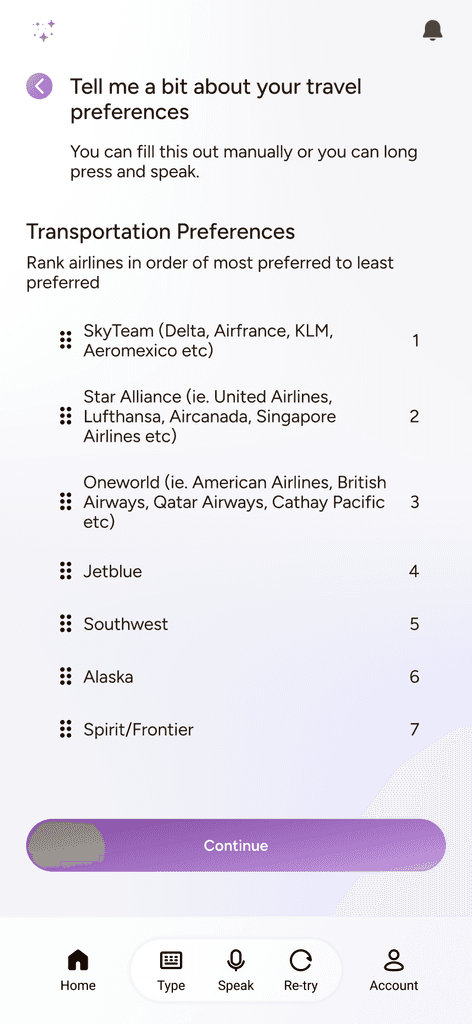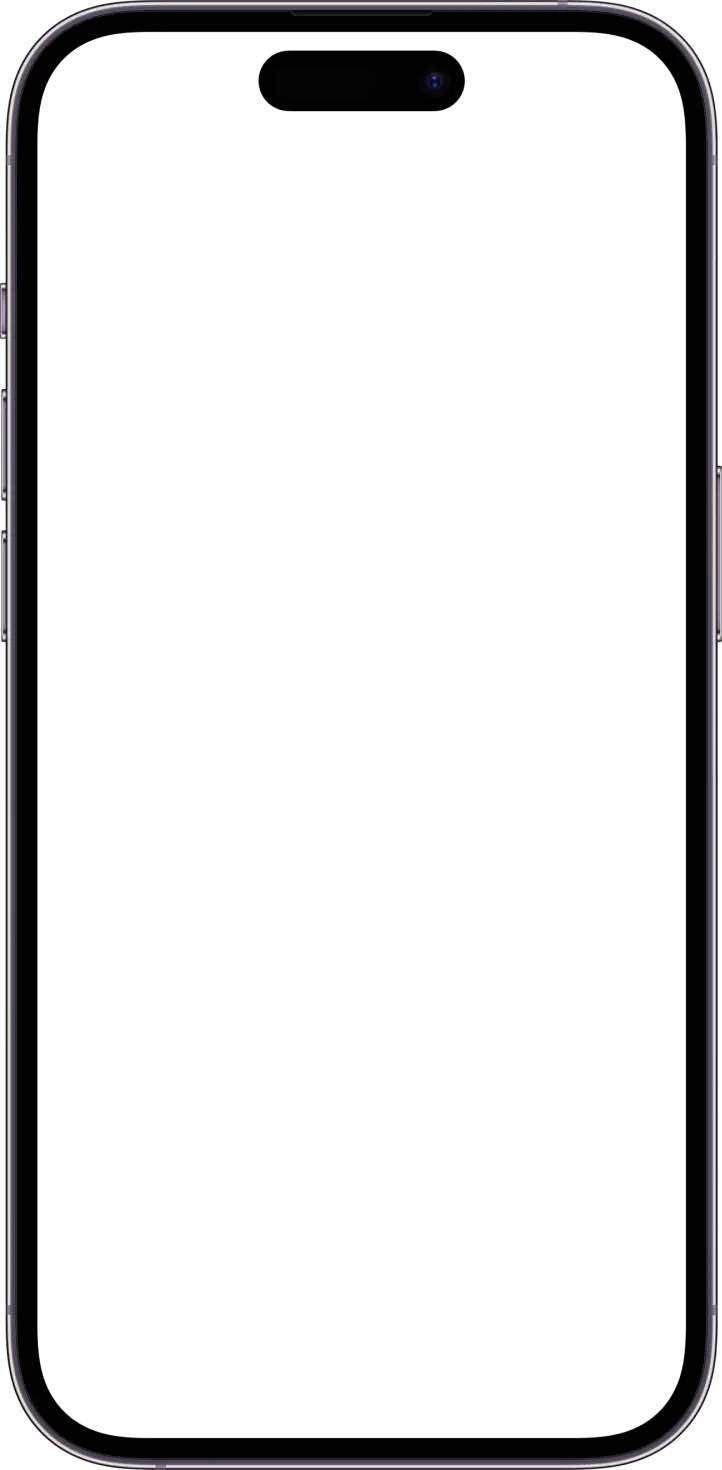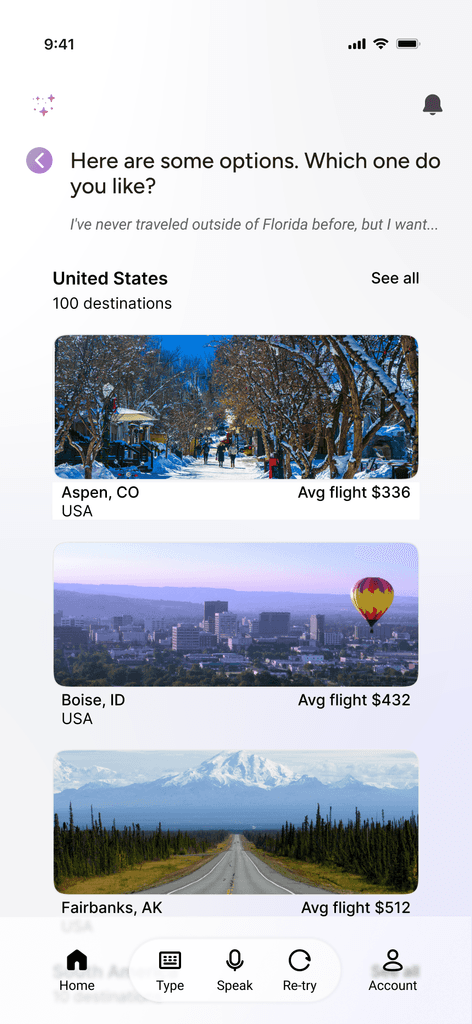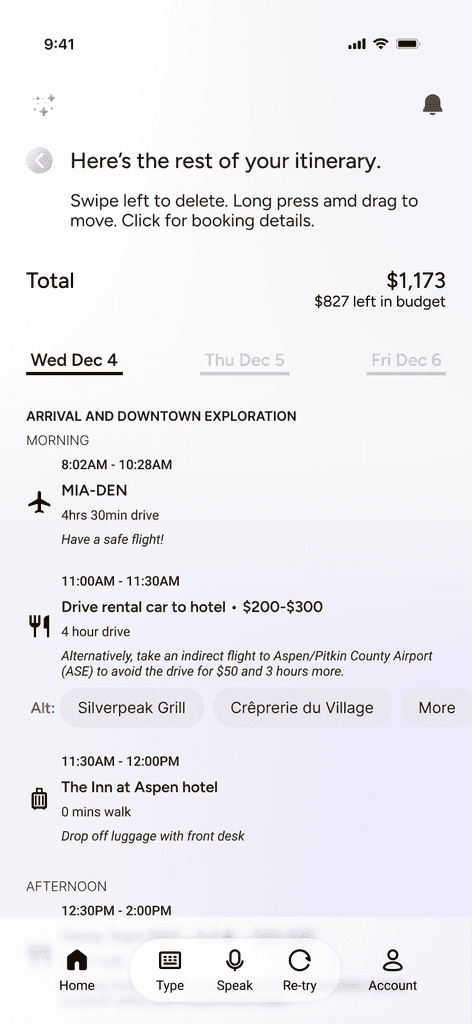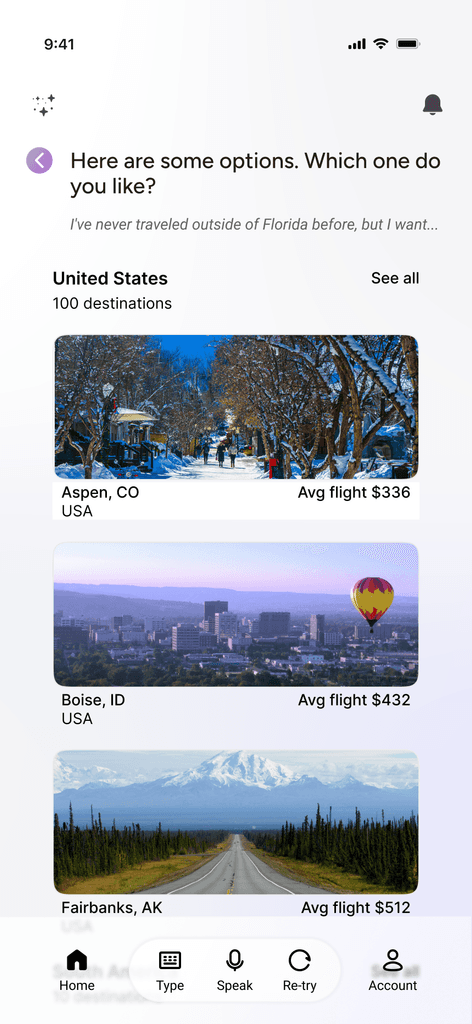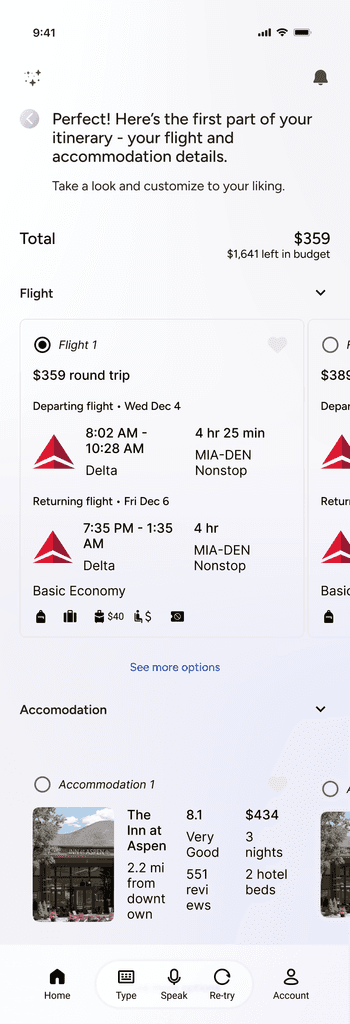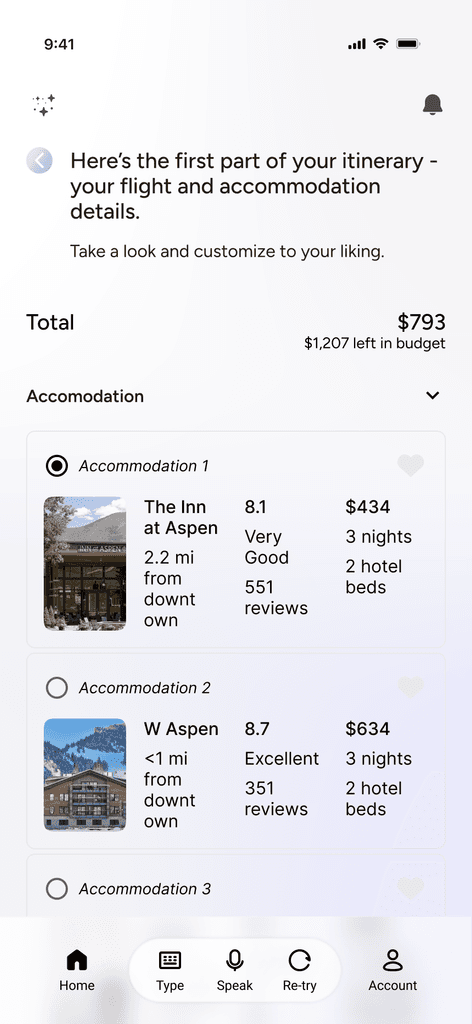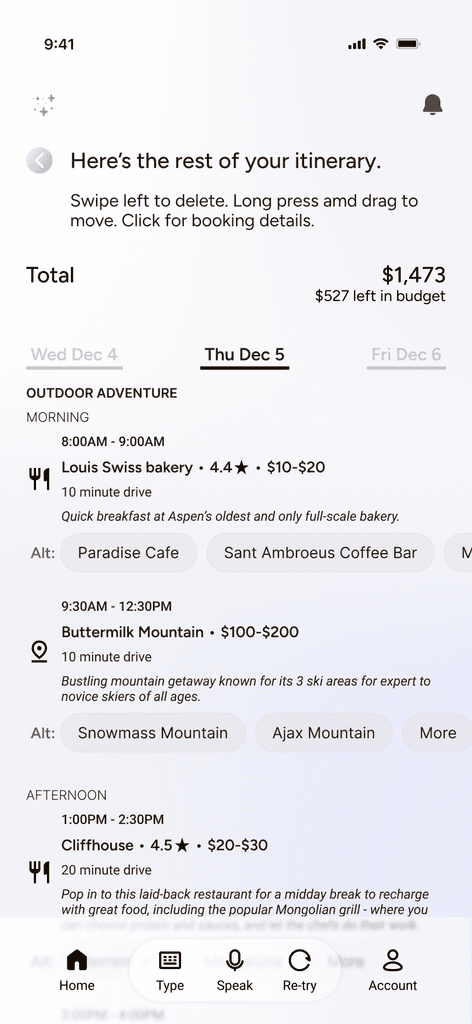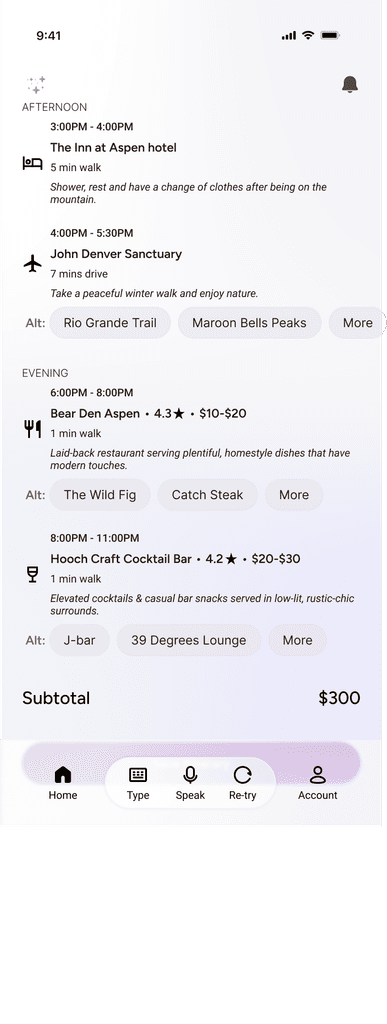0-1 native app
AI Travel App for Inexperienced Travelers
Vacay Fairy means less time planning and more time packing
I undertook a 4-step process to land on the final experience:
User Research
To understand the specific challenges faced by infrequent travelers, we conducted surveys and interviews with target users. Key insights included:
Overwhelmed by choices: Users felt inundated with information, unsure which destinations would be most suited to their preferences.
Lack of time: Many felt insecure about making quick decisions without hours of research or expert guidance but often felt they didn't have enough time to invest
Desire for budget management: There was a strong need for help in balancing travel desires with financial constraints.
Personas
I adopted a user-centered design approach, ensuring that every step of the process was informed by feedback from real users. I created personas to represent the target audience:
Sophia: A 28-year-old graphic designer who loves to travel but has only visited 1-2 places in her life. She seeks new experiences but is overwhelmed by how many things need to be taken into consideration.
Alex: A 35-year-old consultant who rarely travels due to his busy work schedule. He wants a convenient way to plan vacations that are stress-free.
— "I love the idea of traveling, but planning trips is so overwhelming with all the options out there. It would be amazing if something could help me figure out where to go and what to do without having to spend hours researching every detail."
Affinity Map
There were 3 recurring themes and challenges from the research:
complexity
Users often feel overwhelmed by the number of options and tasks required for trip planning; they need a simpler experience.
"There are just too many websites to check for flights and hotels."
"I find it hard to compare destinations."
"I’m not sure how to budget for a trip, especially when I don’t know what’s important to spend on."
"I get overwhelmed by the number of options and feel stuck."
personalization
There’s a strong desire for personalized recommendations that fit the user’s preferences and budget.
"It would be great if I could get personalized suggestions for destinations."
"I wish there was a way to easily create an itinerary with everything in one place."
budget & doubt
Concerns about overspending, especially on what may be the wrong destination or choice for them; users want trustworthy and transparent recommendations.
"I’m afraid of picking the wrong destination and regretting it."
"I really don't want to overspend and regret the whole trip afterwards. That's the worst feeling."
Sitemap
The Vacay Fairy sitemap outlines the user journey from the homepage, where users can explore destination options, to the personalized trip planner, where they input preferences and receive AI-generated itineraries. It includes key sections such as destination recommendations, trip customization, and settings, ensuring a streamlined travel planning experience.
Design & Prototyping
Wireframing
I created low fidelity wireframes to validate both the user experience as well as understand receptiveness to the overall concept.
I also scaled the mobile version of the designs to a desktop variation to understand how the experience might adapt to a larger screen. It combines the usability of a desktop site with the interactivity of a mobile-style AI chat.
Desktop Low Fidelity Wireframes
User Testing & Iteration
After additional user testing, there were 3 high priority areas of feedback that led to iteration:
Improve the ability to edit the itinerary and delete unwanted items
Make it clearer how to interact with the AI assistant and provide suggested prompts for further refinement
Reduce the density of the information displayed for better readability
User Testing
I created low fidelity wireframes to validate both the user experience as well as understand receptiveness to the overall concept. Some key iterations based on feedback were:
Before
After
Interaction for Deleting Events
Before: No obvious way to delete an event
V0
#
After: Swipe gesture makes it easy and fast to delete unwanted options
V1
Interaction for Viewing More Event Options
Before: Dropdown options hidden from view and not very interactive
V0
#
After: Pills provide better visibility and promote engagement
V1
Voice Input and Recognition Display
Before: Unclear when to speak and what can be said
V0
#
After: Visual UI indicates when to speak and text-to-speech displays user text
V1
Activity Details
Before: Details displayed in a dense format with long links laid out
V0
#
After: Bottom sheet enables more digestible display of info and interactable buttons
V1
Trip Planning Click-Based vs AI Based Interaction
Before: UI-heavy presentation suggests AI feature is limited and user should manually click to search and filter
V0
#
After: Consistently conversational UI promotes voice/text conversation and more ambiguous prompting for a more engaging experience
V1
Design & Development
UI Design
I designed a friendly and approachable UI that reflects the idea of a "travel fairy" helping users. The color palette featured soft blues, greens, and purples to evoke calm and trust. We also incorporated playful elements like map pins, fairies, and soft gradients to add charm without overwhelming the interface.
AI Integration
The core of Vacay Fairy’s functionality lies in its AI engine. It:
Analyzes travel trends, user preferences, and past behaviors to recommend the best destinations.
Curates itineraries based on preferences (e.g., adventure, relaxation) and provides options for local experiences.
Offers conversational dialogue, so even the most novice user can guarantee a great outcome
Logo
Minimalist, clean font
Subtle gradient of soft purple and pink hues
Fairy dust represents whimsical, fun branding
color palette
Primary brand colors create a bright, energetic brand aesthetic
Evokes feelings of warmth, joy and playfulness
Secondary brand colors provide a neutral, versatile foundation
Enhances readability, balances vibrant primary colors
Adds a modern but inviting touch
TYPEOGRAPHY
Figtree font is clean, slightly rounded, and highly legible across sizes
Simple and evokes a sense of innovation
Facilitates a cohesive brand identity with attention-grabbing headers and substantial weight
UI Elements
Used various UI elements to create a cohesive product experience.
- It was especially important that many elements appear interact-able and provides users with multiple ways to customize their travel plans or get more information.
- I borrowed from common patterns to ensure the voice input is an intuitive and responsive experience for maximum engagement, especially on mobile
The resulting solution is an AI-powered travel app that simplifies trip planning for all travelers. The app addresses common pain points for those who find travel planning stressful or confusing, especially first-time or infrequent travelers.
Destination Selection
Based on user preferences, Vacay Fairy suggests ideal locations, saving users hours of research.
AI Generated Itinerary
A flexible itinerary builder allows users to tweak their travel plans, with AI helping to suggest time-efficient routes.
Integrated Budget Management
Integrated budgeting helps users stay on track by showing cost estimates for accommodation, food, and activities.
The results of the beta launch have been positive, with initial results showing enthusiasm and effectiveness even with initial usage.
User CSAT
90% of users who tested the app during a beta phase found the AI-generated itineraries helpful and said they would use the app for future travel planning.
Improved Confidence
Users reported feeling significantly more confident in their travel choices, with 85% stating they were more likely to visit new destinations thanks to Vacay Fairy’s recommendations.
Wallet Saving
The app’s budgeting tools were a hit, with 75% of users reporting they felt more in control of their spending.
Interactive Prototype
Expand to full screen for best functionality
Based on user feedback, the future iterations of Vacay Fairy will focus on:
Expanding the recommendation engine to include even more niche activities (e.g., eco-friendly trips, culinary adventures).
Improving integration with booking platforms, so users can seamlessly book hotels, flights, and activities directly through the app.
Developing a social-sharing feature, allowing users to share their itineraries and travel experiences with friends and family.
I was excited to take on this project because I know the audience very closely; they represent some of my close friends and family who are eager to travel but also terrified of everything they don't know. I enjoyed the process of gaining more insights from the people I interviewed as well as figuring out the best way to integrate conversational AI into the experience to make it as user friendly as possible. The biggest challenge was figuring out how to make each step of the journey simple and easy to follow. I look forward to future iterations where I can continue to simplify the experience and make it more visually appealing.


